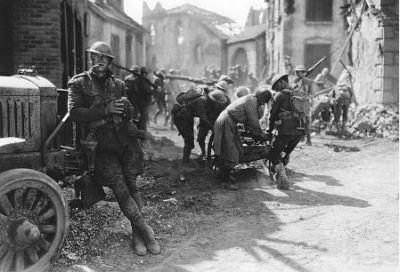
WHAT PRICE GLORY
(Gloria, USA/1926) R.: Raoul Walsh. D. 120'. Did. inglesi
Accompagnamento al piano di Neil Brand
"Stop the blood", grida straziato il soldato più giovane, sensibile come un artista e figlio devoto di mamma: il sangue che dovrebbe, ma non può, essere fermato è quello della ferita che lo sta uccidendo e altrettanto è quello della carneficina in atto, chiamata Prima guerra mondiale. L'urlo finale di un altro figlio devoto ("Ma, I'm top of the world!"), variante però decisamente psicotica, sarà una delle vette vertiginose del cinema di Walsh, quando nella Furia umana il gangster James Cagney sale sul gasometro pronto a farsi saltare in aria insieme al mondo e al suo gigantesco complesso d'Edipo. Qui tutto è più semplice, nell'antimilitarismo sincero e screziato di retorica della Hollywood anni Venti, dove un Victor McLaglen può chiedersi, con intuito profetico da brividi, che razza di civiltà sia questa che ogni trent'anni ha bisogno di rifondarsi nel macello d'una generazione. What Price Glory, che esce un anno dopo il trionfo commerciale di The Big Parade (King Vidor per Thalberg/MGM), è il primo vero film di guerra di Walsh, dopo un paio di melodrammi patriottici girati nei tardi anni Dieci: la sua guerra è anche il dettaglio dei bulloni su mezzi pesanti in marcia, la luce sinistra su corpi sacrificabili e baionette allineate, e poderosi carrelli all'indietro in trincee già quasi kubrickiane. Tuttavia la guerra combattuta non occupa anche qui che un tempo minore, le scene di guerra sono incisioni, fratture, appunto ferite (a volte non rimarginabili) nel corpo d'un film che ha i solidi contorni e cliché della commedia virile (rivalità amorosa tra compagni d'armi, un po' come in La carne e il diavolo di Clarence Brown, che essendo però un dramma non nascondeva troppo il suo coté omosessuale, o in A Girl in Every Port e Avventurieri dell'aria di Hawks). A conti fatti, quel che più conta di What Price Glory sembrano quei quaranta metri quadrati di campagna francese sempre attraversati da una dondolante processione di oche, la taverna con l'oste baffuto, e personaggi femminili che entrano in campo annunciati dal piano ravvicinato d'un polposo posteriore. Il film è estremamente sessualizzato, bluse che scivolano tra seno e spalla e giarrettiere con la coccarda e calzerotti di lana che si srotolano lenti (un'idea di erotismo campagnard), d'altra parte Dolores Del Rio lo sa e lo dice chiaro e tondo: l'amore del cuore è una cosa, ma l'amore tutt'intero ("he does have all my love"), ragazzi, è un'altra cosa - e dunque, ancora una volta, la gran stazza irlandese di Victor McLaglen deve rassegnarsi. Raoul Walsh ha oltre trenta film dietro le spalle e tutta la vita davanti, ma già sembra chiara la sua divisa: quella d'una voce, di un'energia, di un'ironia che sapranno muovere il cinema ("Il cinema è movimento. E io lo facevo muovere"), con sempre maggior sicurezza e talora con genio, non versus ma dentro la formule, il codice, la grande norma hollywodiana.
(Paola Cristalli)
"Stop the blood!" screams the youngest soldier - a mother's boy with the soul of a poet. The unstoppable blood he is referring to is the blood pouring from his wound, as well as the blood from the ongoing massacre of the First World War. The final - and psychotic - scream from another mother's boy ("Ma, I'm top of the world!") will be one of the high points of Walsh's cinematic oeuvre, when in White Heat James Cagney jumps on the gasometer - ready to blow himself up along with the rest of the world and his own over-sized Oedipus complex. Here, in the sincere and soft-toned anti-military rhetoric of 1920s Hollywood, everything is simpler: and Victor McLaglen can wonder, with chilling prophetic intuition, what kind of civilization finds the need to wipe out a generation of young men every thirty years. What Price Glory, which was released a year after the commercially successful The Big Parade (King Vidor for Thalberg/MGM), is Walsh's first real war movie, after a couple of patriotic melodramas in the late 1910s. War in his eyes is made of close-ups of bolts on a convoy of tanks, is the sinister light on a row of bayonets and expendable bodies, and powerful travellings in almost Kubrickesque trenches.
The fighting, however, takes up minor screen time: the war scenes are incisions, fractures, wounds (which sometimes never heal) in a filmic body that has all the solid contours and clichés of a masculine comedy (love rivalries between fellow soldiers, as in Flesh and the Devil by Clarence Brown, which, being a drama, didn't mask too much its homosexual undertones, or in A Girl in Every Port and, many years later, Only Angels Have Wings by Hawks...). The core of What Price Glory seems to be in those forty square meters of French countryside with its wavering procession of geese, the tavern with the mustachioed owner, and the female characters who enter most scenes with a close-up shot of their fleshy posteriors. It is a highly sensual film, with blouses slipping off shoulders and wool stockings on shapy legs and garters very slowly rolled up (an idea of eroticism très campagnard): as Dolores Del Rio says loud and clear, love of the heart is one thing, but the whole of her love ("he does have all my love") is quite another entirely. And so, once again, the Irish 'wild bull' Victor McLaglen needs to learn to live with it. Raoul Walsh has some thirty films behind and a whole life ahead of him, and his uniform already seems to fit perfectly: a voice, an energy and a sense of humour that know how to move cinema ("Cinema is movement. And I made it move"), with increasing confidence and flashes of genius. Not going against, but moving within the Hollywood formula.
(Paola Cristalli)


Tariffe:
Aria condizionata
Accesso disabili
Tel. 051 522285











